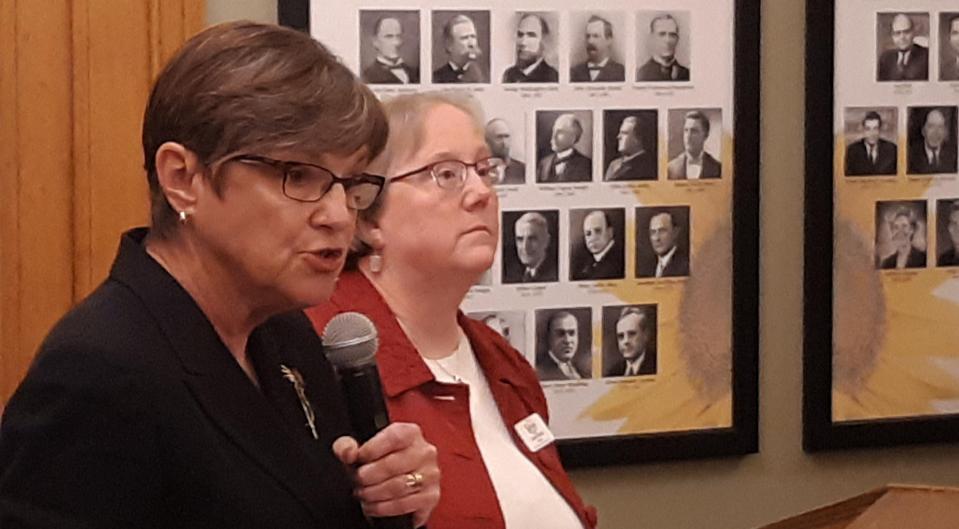Kansans with disabilities wait a decade for services. How this program could speed that up
- Oops!Something went wrong.Please try again later.
Kansas is developing a second option for people seeking an Intellectual and Developmental Disability support waiver.
IDD waivers fund services like adult daycare, specialized medical care, financial management services and wellness monitoring. It’s one of seven home-and-community-based service waivers available under KanCare, the state’s Medicaid program.
But the waivers haven’t kept up with demand over the years. This month, the Kansas Department for Aging and Disability Services reported that 5,342 Kansans are on a wait-list to receive services. Some families reported a decade-long delay between applying for and receiving a waiver.
Politicians on both sides of the aisle have spoken out about the issues facing those on the I/DD waitlist.
House Speaker Dan Hawkins, R-Wichita, identified the waitlist as a priority this session, often while reiterating his opposition to Gov. Laura Kelly’s proposal to expand Medicaid.

Previously Kelly focused on raising the reimbursement rate for medical providers who accept vouchers, which has led to a stagnant number of patients it can accept — around 9,100. Kansas is obligated to serve 9,100 people but doesn’t allocate more funding after that.
The Legislature has usually been the one to add more funding in the program rather than Kelly, but in February, she amended her budget proposal to increase the number of people it can serve. The $23 million investment would add 250 slots to the I/DD waiver program and 250 for the Physical Disability waiver, which also has a hefty backlog. That’s about a 5% cut in the I/DD waiver waitlist, and 10% to the PD waitlist.
The final budget bill sent to the governor doubled the amount of slots from the governor’s recommendation and mandated that the waitlist be kept below 4,800 people — a suggestion Kelly rejected in a line-item veto. Legislators may be able to maintain their preference as they amend the budget.
The community support waiver would offer 'light' option
The community support waiver is one way Kansas is trying to chip away at the growing list of people waiting for services. It isn't yet available, but it's meant for people who need a lower level of service than a full-on I/DD waiver recipient.
“The CSW is a ‘light’ waiver. It offers a more limited array of services. The current IDD Waiver is what’s known as a ‘comprehensive’ waiver,” said Rocky Nichols, executive director of Disability Rights Center of Kansas.
Services for the CS waiver would place an emphasis on supported employment, a type of vocational training that helps disabled people find work. Work on the proposals also highlight respite care, which is when a waiver recipient gets help from someone who is not their primary caregiver for a short period of time.
"It's those jobs support and day to day service," Nichols said. "They're competitively employed, they're making more than minimum wage and they're in an integrated setting. They're not just segregated with other people with disabilities."
It would also cap how much services someone could get in the program. The exact number hasn’t been decided, but proposals show a maximum payment of $20,000.
KDADS estimated that the range of participants could be anywhere between 3,600 and 7,461. Though that could impact the wait times for services, Nichols said it’s unlikely it’ll be a silver bullet.
“We fully support the CS waiver. For all the people on I/DD waitlist who don’t need a comprehensive waiver slot, this will help and is much needed. Unfortunately, the last I heard the CS waiver would not be implemented until 2026. Even when it is fully implemented, the CS waiver will not eliminate the waitlist. It and many more slots on the comprehensive waiver can be part of a bigger plan to eliminate the waitlist,” Nichols said.
The investment needed to fully eliminate wait times for the I/DD waitlist would require a more significant investment than either the legislature or governor has proposed. The Kansas Legislative Research Department estimated that it would take around $200 million more dollars to alleviate wait times, but it noted that the current workforce isn’t large enough to meet the demands of that many new patients.
When the governor announced her proposed increase in funding, Nichols called on legislators to reduce waitlists by 20% in the upcoming budget and to gradually eliminate the waitlist over a five-year period.
In the meantime, KDADS is taking steps on creating a CS waiver. Recently, it hired Public Consulting Group to assist it in the creation of the new waiver.
“By developing a new Community Support Waiver and restructuring support systems through this partnership, we are taking a significant step toward better serving these Kansans,” Kelly said.
This article originally appeared on Topeka Capital-Journal: Kansas is creating a lower-barrier waiver for disability services

